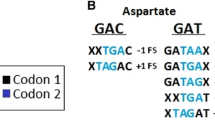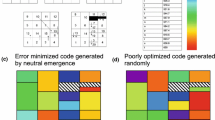Abstract
Statistical and biochemical studies have revealed nonrandom patterns in codon assignments. The canonical genetic code is known to be highly efficient in minimizing the effects of mistranslational errors and point mutations, since it is known that, when an amino acid is converted to another due to error, the biochemical properties of the resulted amino acid are usually very similar to those of the original one. In this study, we have taken into consideration both relative frequencies of amino acids and relative gene copy frequencies of tRNAs in genomic sequences in order to introduce a fitness function which models the mistranslational probabilities more accurately in modern organisms. The relative gene copy frequencies of tRNAs are used as estimates of the tRNA content. We also altered the rule previously used for the calculation of the probabilities of single base mutation occurrences. Our model signifies higher optimality of the genetic code towards load minimization and suggests the presence of a coevolution of tRNA frequency and the genetic code.
Similar content being viewed by others
References
Amirnovin, R., 1997. An analysis of the metabolic theory of the origin of the genetic code. J. Mol. Evol. 44, 473–476.
Archetti, M., 2004. Codon usage bias and mutation constraints reduce the level of error minimization of the genetic code. J. Mol. Evol. 59(2), 258–266.
Ardell, D.H., 1998. On error-minimization in a sequential origin of the standard genetic code. J. Mol. Evol. 47, 1–13.
Ardell, D.H., Sella, G., 2001. On the evolution of redundancy in genetic codes. J. Mol. Evol. 53, 269–281.
Benner, S.A., Cohen, M.A., Gonnet, G.H., 1994. Amino acid substitution during functionally constrained divergent evolution of protein sequences. Protein Eng. 7, 1323–1332.
Chechetkin, V.R., 2003. Block structure and stability of the genetic code. J. Theor. Biol. 222, 177–188.
Crick, F.H., 1968. The origin of genetic code. J. Mol. Biol. 38, 367–379.
DiGiulio, M., 2000. The origin of the genetic code. Trends Biochem. Sci. 25, 44–47.
DiGiulio, M., 2001. The origin of the genetic code cannot be studied using measurements based on the PAM matrix because this matrix reflects the code itself, making any such analyses tautologous. J. Theor. Biol. 208, 141–144.
Dillon, L.S., 1973. The origins of the genetic code. Bot. Rev. 39, 301–345.
Dong, H., Nilsson, L., Kurland, C.G., 1996. Co-variation of tRNA abundance and codon usage in Escherichia coli at different growth rates. J. Mol. Biol. 260, 649–663.
Fink, T.R., Crothers, D.M., 1972. Free energy of imperfect nucleic acid helices. J. Mol. Biol. 66, 1–12.
Freeland, S.J., 2002. The genetic code: an adaptation for adapting? J. Genet. Program. Evol. Mach. 3(2), 113–127.
Freeland, S.J., Hurst, L.D., 1998a. Load minimization of the genetic code: history does not explain the pattern. Proc. R. Soc. Lond. B 266, 2111–2119.
Freeland, S.J., Hurst, L.D., 1998b. The genetic code is one in a million. J. Mol. Evol. 47, 238–248.
Freeland, S.J., Knight, R.D., Landweber, L.F., Hurst, L.D., 2000. Early fixation of an optimal genetic code. Mol. Biol. Evol. 17, 511–518.
Gilis, D., Massar, S., Cerf, N.J., Rooman, M., 2001. Optimality of the genetic code with respect to protein stability and amino acid frequencies. Genome Biol. 2(11), 49.1–49.12.
Goldberg, A.L., Wittes, R.E., 1966. Genetic code: aspects of organization. Science 153, 420–424.
Goodarzi, H., Nejad, H.A., Torabi, N., 2004. On the optimality of the genetic code with the consideration of termination codons. Biosystems 77(1–3), 163–173.
Goodarzi, H., Najafabadi, H.S., Hassani, K., Nejad, A.H., 2005. On the optimality of the genetic code, with the consideration of coevolution theory by comparison of prominent cost measure matrices. J. Theor. Biol. 235(3), 318–325.
Haig, D., Hurst, L.D., 1991. A quantitative measure of error minimization on the genetic code. J. Mol. Evol. 33, 412–417.
He, L., Kierzek, R., SantaLucia, J., Walter, A.E., Turner, D.H., 1991. Nearest-neighbor parameters for G.U mismatches. Biochemistry 30, 11124–11132.
Ikemura, T., 1981. Correlation between the abundance of Escherichia coli transfer RNAs and the occurrence of the respective codons in its protein genes. Nucleic Acids Res. 28, 3517–3523.
Judson, O.P., Haydon, D., 1999. The genetic code: what is it good for? J. Mol. Evol. 49, 539–550.
Kanaya, S., Yamada, Y., Kudo, Y., Ikemura, T., 1999. Studies of codon usage and tRNA genes of 18 unicellular organisms and quantification of Bacillus subtilis tRNAs: gene expression level and species-specific diversity of codon usage based on multivariate analysis. Gene 238, 143–155.
King, J.L., Jukes, T.H., 1969. Non-Darwinian evolution. Science 164, 788–798.
Knight, R.D., Freeland, S.J., Landweber, L.F., 2001. Rewiring the keyboard: evolvability of the genetic code. Nat. Rev. Genet. 2, 49–58.
Luo, L., Li, X., 2002. Coding rules for amino acids in the genetic code: the genetic code is a minimal code of mutational deterioration. Orig. Life 32, 23–33.
Mathews, D.H., Sabina, J., Zuker, M., Turner, D.H., 1999. Expanded sequence dependence of thermodynamic parameters improves prediction of RNA secondary structure. J. Mol. Biol. 288, 911–940.
Pele, S.R., 1965. Correlation between coding-triplets and amino acids. Nature 207, 597–599.
Percudani, R., Pavesi, A., Ottonello, S., 1997. Transfer RNA gene redundancy and translational selection in Saccharomyces cerevisiae. J. Mol. Biol. 268, 322–330.
Ronneberg, T.A., Landweber, L.F., Freeland, S.J., 2000. Testing a biosynthetic theory of the genetic code: fact or artifact? Proc. Natl. Acad. Sci. USA 97, 13690–13695.
Woese, C.R., 1965a. On the evolution of the genetic code. Proc. Natl. Acad. Sci. USA 54, 1546–1552.
Woese, C.R., 1965b. Order in the genetic code. Proc. Natl. Acad. Sci. USA 54, 71–75.
Woese, C.R., Dagre, D.H., Dagre, S.A., Kondo, M., Saxinger, W.C., 1966a. On the fundamental nature and evolution of genetic code. Cold Spring Harb. Symp. Quant. Biol. 31, 723–736.
Woese, C.R., Dugne, D.H., Saxinger, W.C., Dayre, S.A., 1966b. The molecular basis for the genetic code. Proc. Natl. Acad. Sci. USA 55, 966–974.
Wong, J.T., 1975. A co-evolution theory of the genetic code. Proc. Natl. Acad. Sci. USA 72, 1909–1912.
Author information
Authors and Affiliations
Corresponding author
Rights and permissions
About this article
Cite this article
Goodarzi, H., Najafabadi, H.S., Nejad, H.A. et al. The impact of including tRNA content on the optimality of the genetic code. Bull. Math. Biol. 67, 1355–1368 (2005). https://doi.org/10.1016/j.bulm.2005.03.002
Received:
Accepted:
Issue Date:
DOI: https://doi.org/10.1016/j.bulm.2005.03.002




